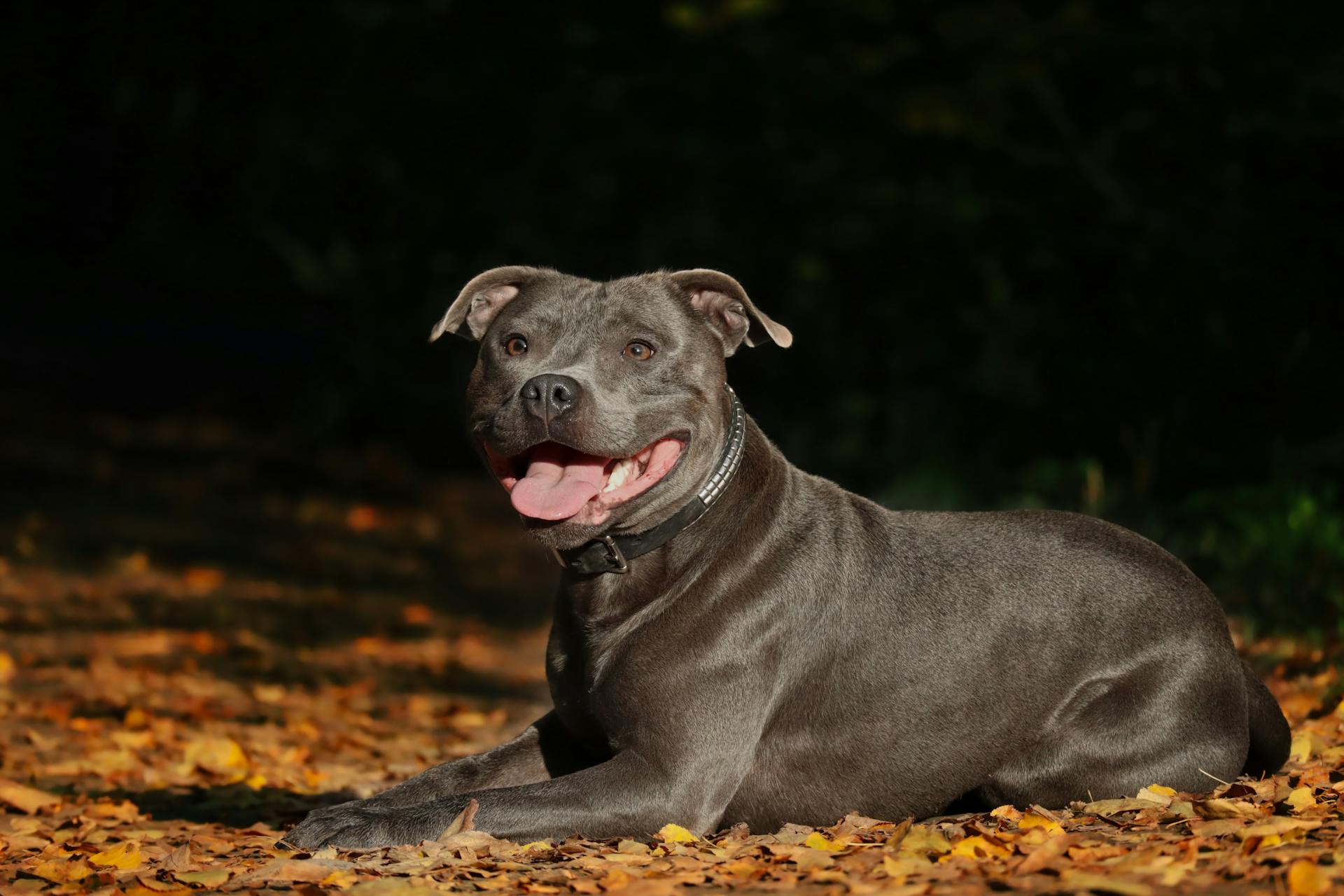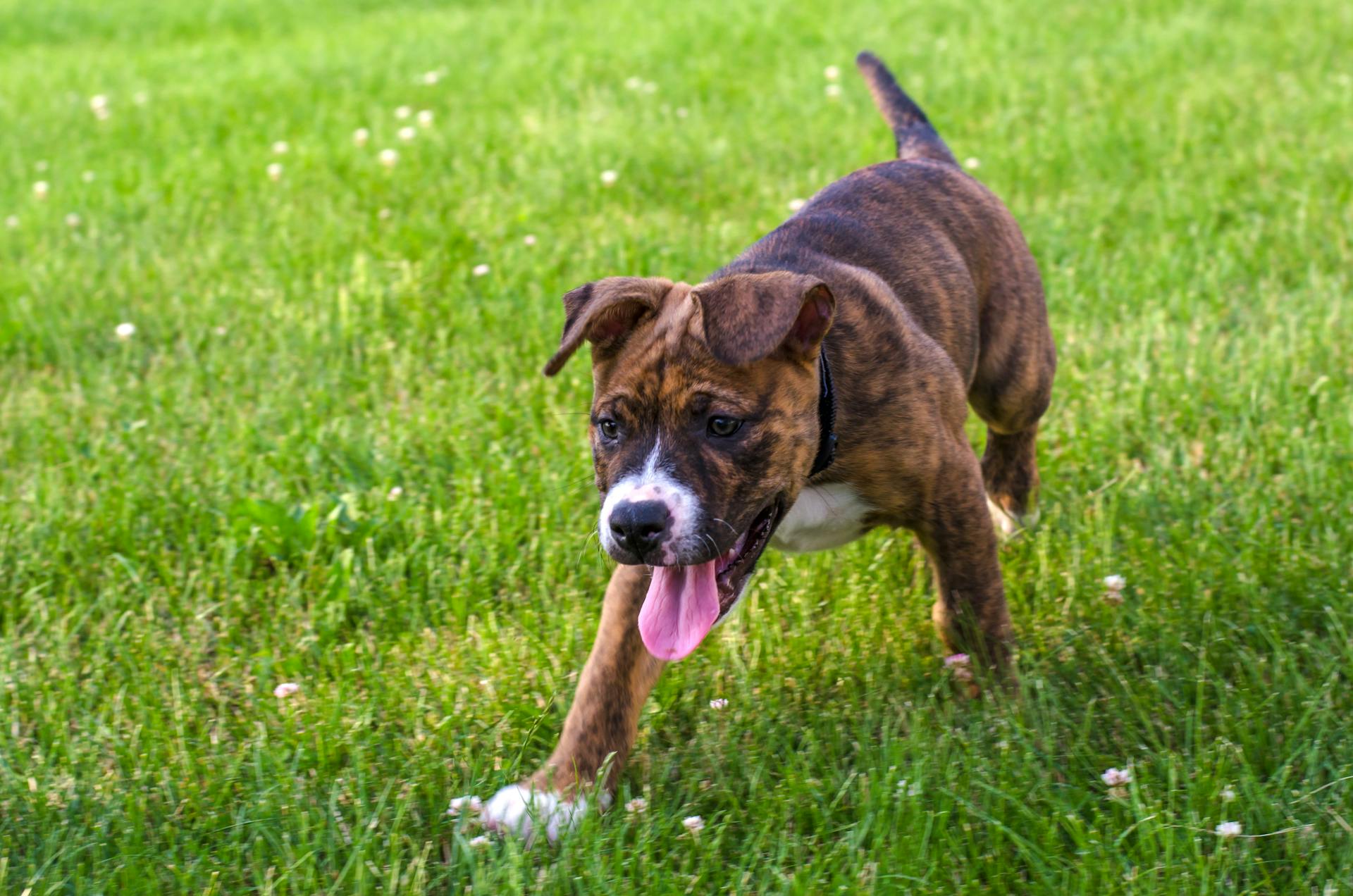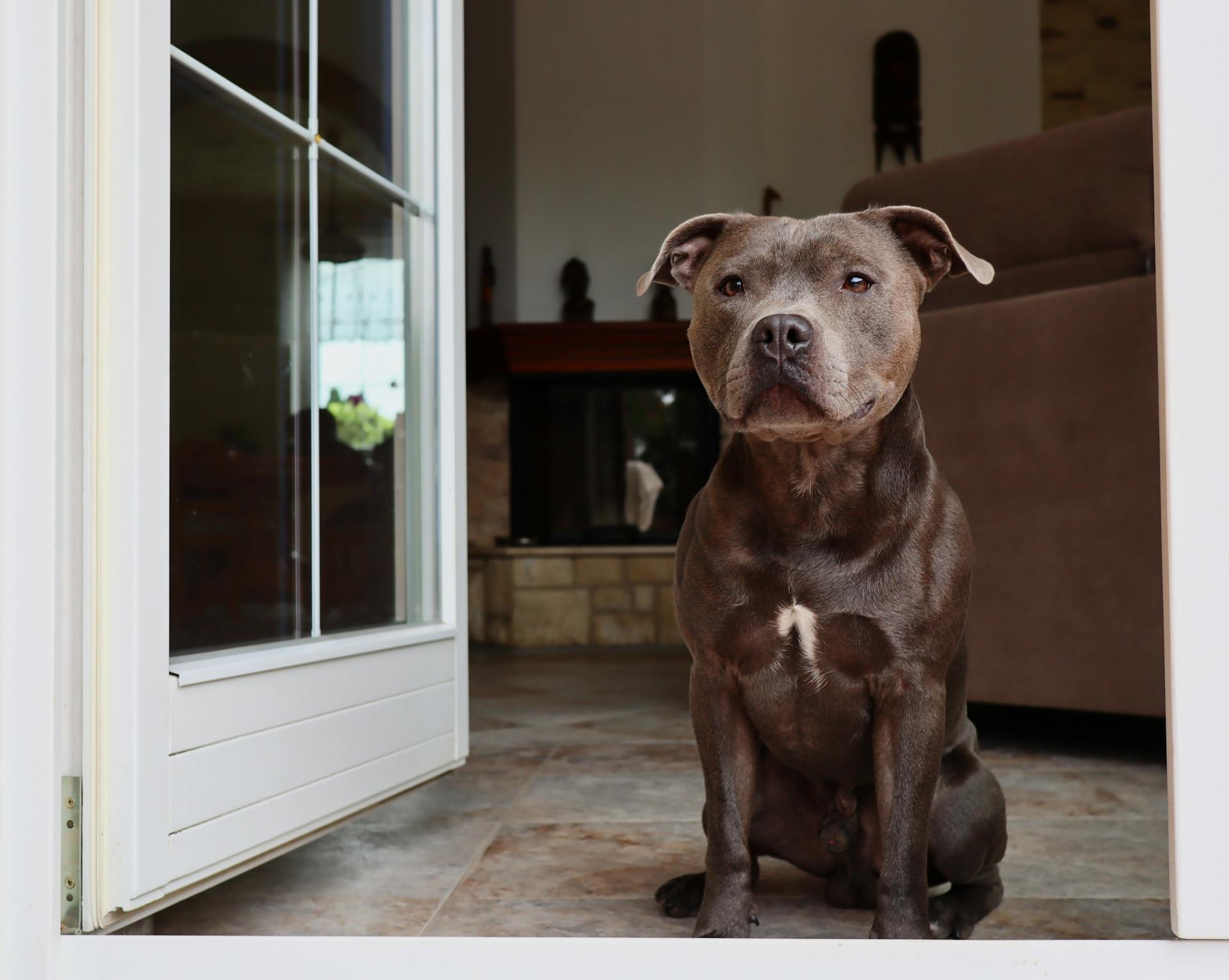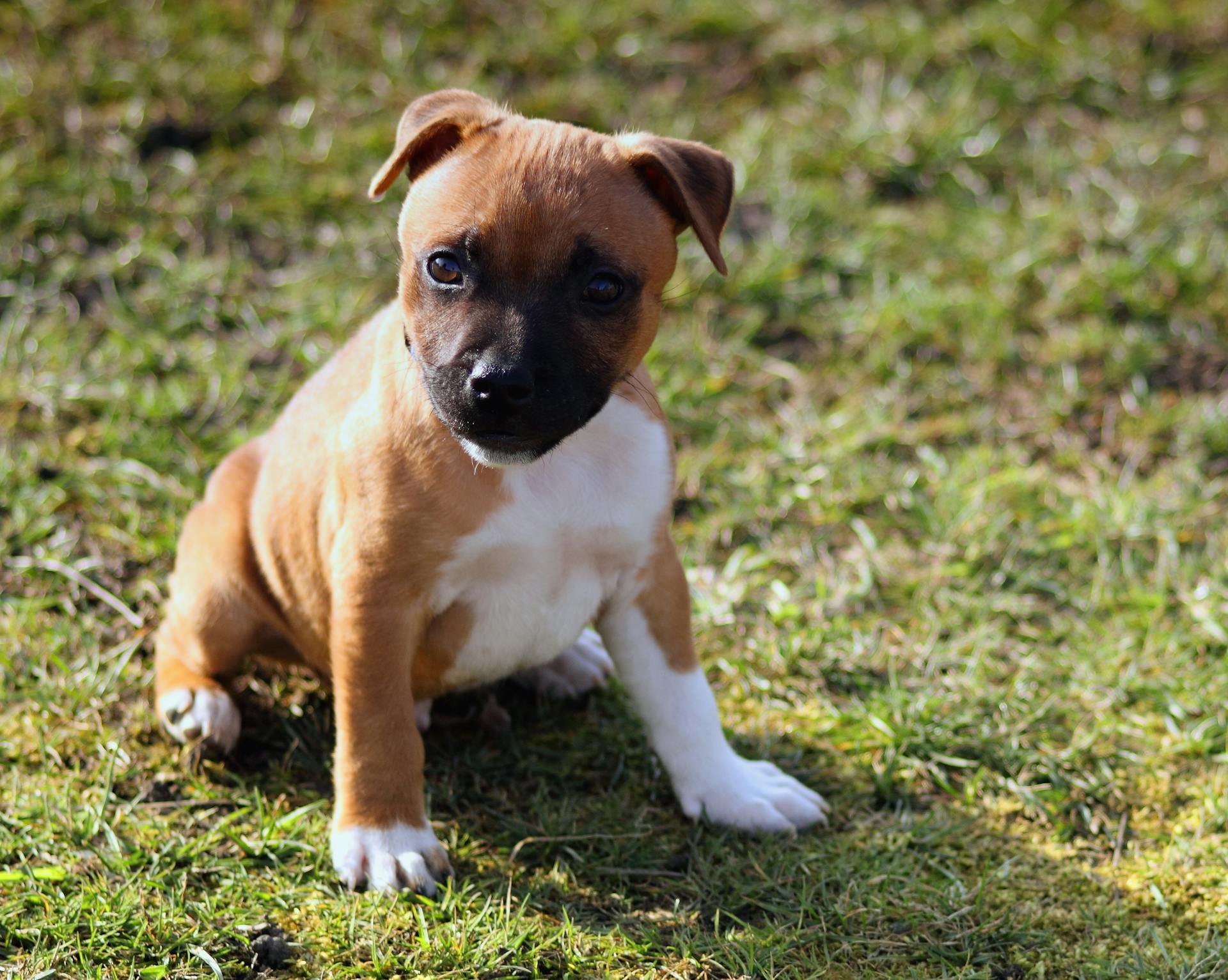
Staffy training can be a challenge, but with the right approach, you can raise a well-behaved and loving companion.
Staffordshire Bull Terriers are known for their strong will and determination, which makes them a great breed for experienced owners. Their short coat requires minimal grooming, but they do need regular exercise to stay happy and healthy.
To start training, it's essential to establish a strong bond with your Staffy based on trust, respect, and positive reinforcement. This will help them listen to you and respond to commands.
Housebreaking is a crucial part of Staffy training, and it's best to start with short, frequent sessions in a designated area to avoid accidents. Consistency is key, so establish a routine and stick to it.
Understanding the Breed
Staffordshire Bull Terriers, also known as Staffies, are loyal and intelligent dogs that thrive in family environments. They are pack animals and need to know their place in the pack.
To establish a strong bond with your Staffy, it's essential to establish yourself as the pack leader early on in the training process. This breed can be stubborn, so consistency and patience are key.
Early socialization is critical for Staffies, as they can be wary of strangers. Expose them to different people, sights, sounds, and experiences from an early age to help them develop into well-rounded and confident dogs.
Staffies are natural diggers and have a high prey drive, making them unsuitable for homes with other pets. They are also loving and gentle, but can be boisterous, so they should never be left alone with children.
Here are some essential characteristics to keep in mind when training a Staffy:
- Staffies love being around family and are naturally protective of their loved ones.
- They can get competitive and aggressive with other dogs without proper socialization.
- Staffies are not particularly territorial, but will alert you to the presence of visitors, animal or human.
- They love being around their families, so don't do well being left alone for too long.
By understanding these characteristics and needs, you can provide your Staffy with the training and socialization they require to become a well-adjusted and loving companion.
Grooming
Grooming is an essential part of a Staffy's life, and it's not just about making them look good. Grooming should be done every 4 to 8 weeks to ensure their coat and skin are clean.
Suggestion: Dog Grooming Training
Checking their coat and skin is crucial, and you should also clip their nails, clean their ears, and check their anal glands. A rubber grooming mitt or a firm bristle brush can effectively groom the coat without causing discomfort.
Regular grooming can help prevent matting and tangling of their coat, which can be painful for them. It's also a great way to bond with your Staffy and make them feel relaxed and comfortable.
Staffies have a short, smooth coat that lies close to the skin, making it easy to clean. Dirt brushes out easily, and the coat dries quickly after a bath. Brush them weekly to remove dead or loose hair.
Bathing should be done as needed, and it's not necessary to bathe them too frequently as they have little odor. Other grooming needs include dental hygiene and nail care. Brush your Staffy's teeth at least two or three times weekly to remove tartar buildup and the accompanying bacteria.
Training Basics
Training an American Staffordshire Terrier requires consistency and patience. Consistency is key when it comes to obedience training, so choose a set of commands and stick to them.
Obedience training is crucial for American Staffordshire Terriers, and it includes teaching basic commands such as sit, stay, come, and heel. These commands are essential for basic obedience training and help establish a strong bond between the owner and the dog.
Puppy training should start as early as possible, and early socialization is essential for American Staffordshire Terriers. It helps them to become confident and friendly dogs, which is a great foundation for future training.
Basic Obedience
Basic obedience is essential for a well-behaved and happy dog. Consistency is key when it comes to obedience training, so choose a set of commands and stick to them.
Commands such as "sit", "stay", "come", and "heel" are important for basic obedience training. Training sessions should be short and focused, keeping distractions to a minimum and focusing on one command at a time.
Obedience training includes teaching basic commands, which helps to establish a strong bond between the owner and the dog. Early socialization is essential for American Staffordshire Terriers, making them confident and friendly dogs.
Puppy training should start as early as possible, including basic obedience training, potty training, and crate training. Training a new puppy can be a challenging task, but with the right techniques and consistency, it can be a rewarding experience for both the owner and the pup.
To teach your Staffie to sit, use a treat in your hand and tell your pet to sit, then repeat the command a few more times, raising the treat over your pup's head. Your puppy will come running to you for the prize.
To teach your Staffie to walk at your heel, invest in a front-attachment harness and clip it in the front ring of the harness, then focus on loose-leash walking outside. Let your pup walk and see what it does, then call it to return to you when it pulls the leash.
To teach your Staffie to stay, ask your pet to sit or lie down next to you, then walk in front of your pup with your hand still open, and go back to stand next to your dog again.
Finding a Professional
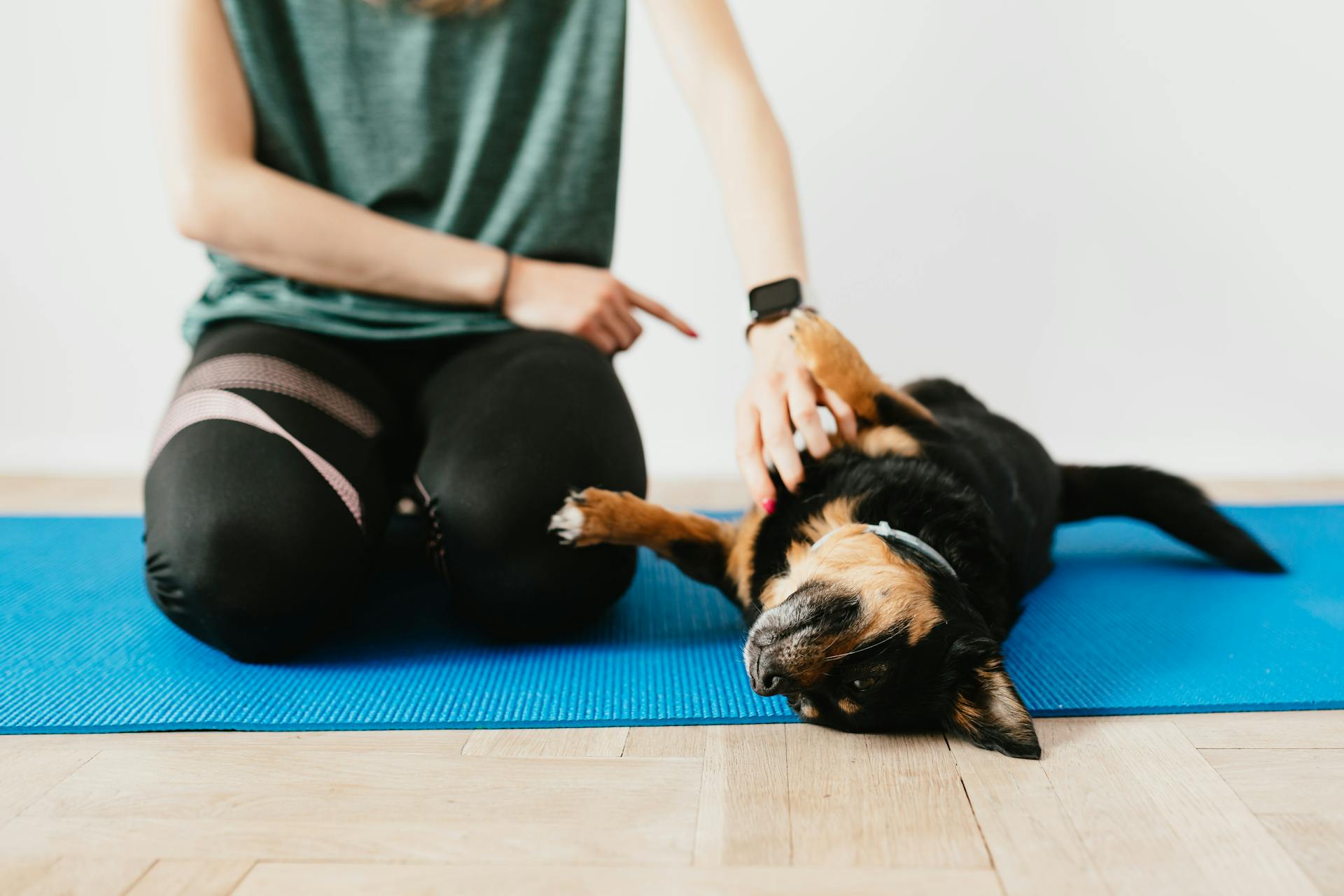
Finding a professional dog trainer can be an excellent option for training an American Staffordshire Terrier.
Start by asking for recommendations from friends, family, or your veterinarian, as they may have valuable insights into a good trainer's reputation and effectiveness.
You can also search online for dog trainers in your area and read reviews from other clients to get a sense of their experience and training methods.
A good trainer should use positive reinforcement techniques and focus on building a strong relationship between you and your dog.
They should also emphasize the importance of leadership and help you establish yourself as the leader in your dog's eyes.
Before committing to a trainer, ask about their experience and credentials, such as completing a certification program or working with dogs in a professional capacity.
Make sure to ask about their availability and pricing to ensure their services fit within your budget and schedule.
A professional dog trainer can help your American Staffordshire Terrier receive the training and socialization they need to be a well-behaved and happy companion.
For more insights, see: Pitbull Staffy Terrier
Exercise Needs
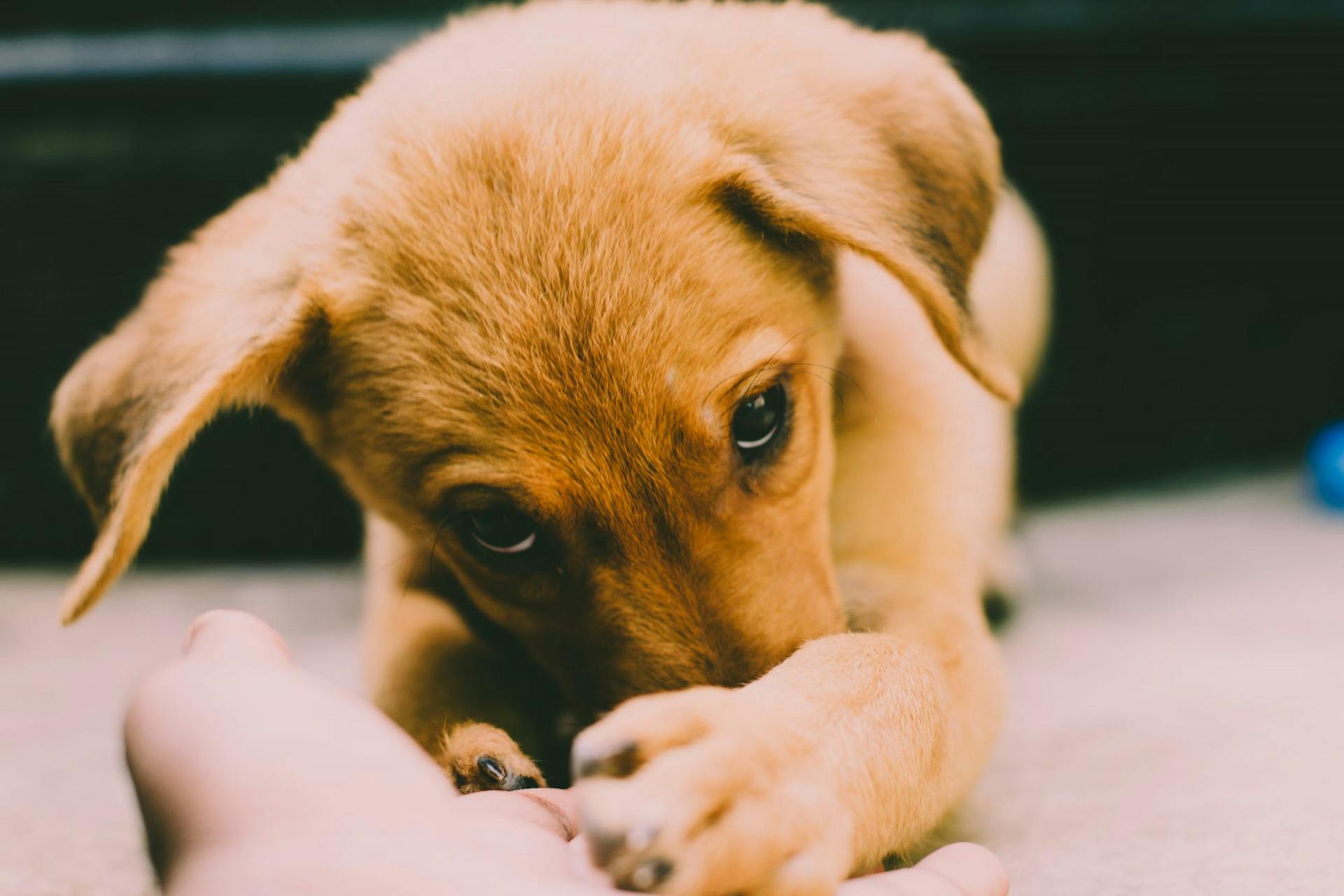
Exercise needs for your Staffordshire Bull Terrier are crucial for their physical and mental well-being. They require at least 1 hour of exercise per day.
This can include brisk walks, playtime in a secure area, and interactive activities such as obedience training or agility. Engaging them in mentally stimulating games and providing puzzle toys can help prevent boredom and destructive behaviors.
Individual exercise needs may vary based on age, health, and energy level. It's essential to consider these factors when determining the right amount of exercise for your dog.
For puppies, short and controlled play sessions throughout the day, combined with regular walks, are suitable. For a 3-month-old puppy, three or four 10-minute play sessions per day are recommended.
Remember to gradually increase the duration and intensity of exercise as they grow, but always be mindful of their physical limitations. Consult with your vet for personalized exercise recommendations based on your puppy's needs.
Housebreaking and Behavior
Housebreaking a staffy requires patience and consistency, as they can be intelligent and trainable. Crate training is a helpful tool in housebreaking, teaching the puppy to hold their bladder and bowels until taken outside.
To begin house training, start with your staffy puppy at four months old, as this is the ideal age to begin. A minimum of six bathroom breaks is necessary at the beginning of training, allowing your furball to become familiar with the routine.
It's essential to establish a routine and stick to it, allowing your staffy to master the drill within four to six months. Don't lose your patience, as housebreaking can be challenging, especially in the beginning stages.
Temperament & Personality
Staffordshire Bull Terriers are loving and gentle dogs that thrive on being around family. They're natural caretakers and make great companions.
Their people-loving personality makes them alert to visitors, whether wanted or unwanted. They'll always let you know when someone's at the door.
Originally bred for sport, Staffies can get competitive and even aggressive with other dogs without proper socialization from an early age. This is why early socialization training is crucial to prevent bad behavior.
As part of the terrier group, Staffordshire Bull Terriers are natural diggers and have a high prey drive, making them unsuitable for homes with other pets.
Here are some key temperament traits to keep in mind:
- Loving and gentle, Staffordshire Bull Terriers love being around family, but should never be left alone with children.
- Originally bred for sport, Staffies can get competitive and even aggressive with other dogs without plenty of socialisation from an early age.
- As part of the terrier group, Staffordshire Bull Terriers are natural diggers and also have an extremely high prey drive so are not suitable for homes with other pets.
- Whilst they’re not particularly territorial, Staffies will “protect” their family members and will alert you to the presence of visitors, animal or human.
Despite their loving nature, Staffordshire Bull Terriers should always be supervised in the presence of toddlers or young children, as they can be rambunctious and may accidentally knock them down.
Housebreaking
Housebreaking is crucial for American Staffordshire Terriers, and they can be trained to do their business outside.
Crate training can be helpful in housebreaking, as it teaches the puppy to hold their bladder and bowels until they are taken outside.
The ideal age to begin house training is around four months, and consistency is key to success.
You'll need to take time out of your busy schedule every day to make housebreaking a priority.
Allowing your puppy to go through a minimum of six bathroom breaks at the beginning of training will help them become familiar with the routine.
It may take a minimum of four to six months for your pup to master the drill of housebreaking.
Behavior
Behavior can be a challenge with American Staffordshire Terriers, especially if they don't receive enough mental and physical stimulation. They are energetic dogs and can become bored if left alone for too long.
Digging, chewing, and barking are common behavioral problems in this breed. Crate training can help redirect their energy and prevent destructive behavior.
To prevent these issues, it's essential to provide plenty of toys and chew items to keep them occupied. You can also try to establish a consistent routine to give them a sense of security and stability.
American Staffordshire Terriers are sensitive dogs and can become anxious in certain situations. Separation anxiety is also common, as they form strong bonds with their owners.
Crate training can be a helpful tool in providing a safe and secure space for your dog when you're not home. This can help reduce anxiety and prevent destructive behavior.
By socializing your dog from an early age and exposing them to different people, animals, and environments, you can help prevent aggression and other behavioral problems. Consistent obedience training can also help establish you as the pack leader and reduce the likelihood of aggressive behavior.
Frequently Asked Questions
Are Staffies difficult dogs?
No, Staffies are not inherently difficult dogs, as research shows they have a similar risk of aggression to other breeds. However, like any dog, proper training and socialization are key to bringing out their friendly and affectionate nature.
Are Staffies easy to train?
Staffies are relatively easy to train, but they require a firm and patient approach due to their stubborn nature. Early training is crucial to bring out their quick learning abilities.
Sources
- https://blog.tryfi.com/how-to-train-your-american-staffordshire-terrier/
- https://stayyy.com/how-to-train-a-staffordshire-bull-terrier/
- https://dogtime.com/dog-breeds/staffordshire-bull-terrier
- https://www.petplan.co.uk/pet-information/dog/breed/staffordshire-bull-terrier/
- https://www.borrowmydoggy.com/doggypedia/dog-breed-guides-staffie
Featured Images: pexels.com
